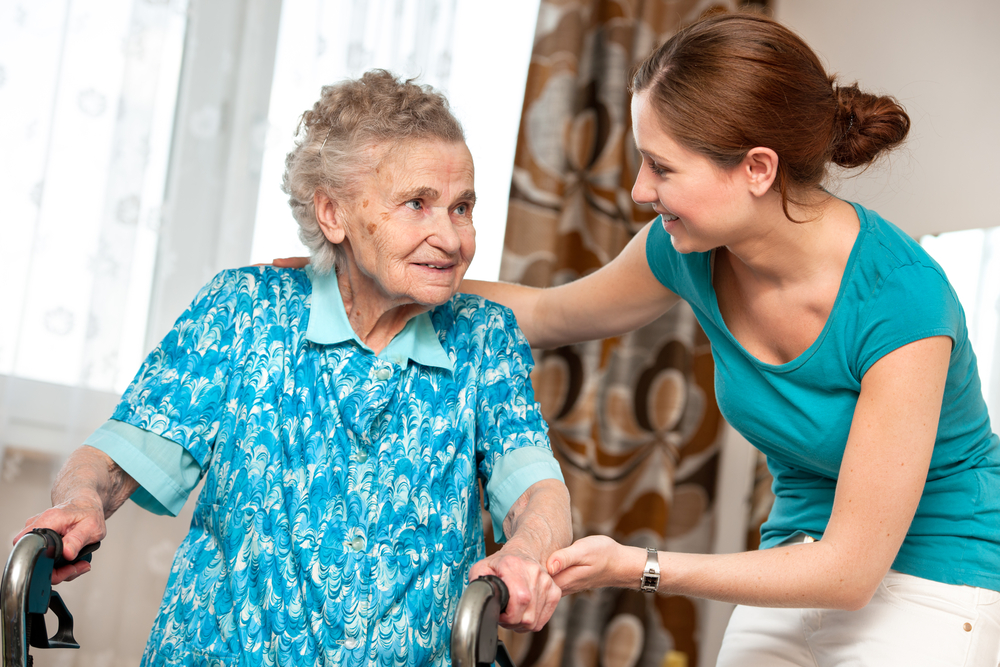Longer life expectancies, new adaptive technologies, and access to virtual care have led to more seniors and people with disabilities aging in place than ever before. And while nearly 80% of adults aged 50+ want to live at home for as long as possible, there is a significant caregiver shortage.
The COVID-19 pandemic taught us many lessons, including that seniors and people with disabilities are highly-vulnerable to public health crises. However, many individuals are isolated and without proper care when they need it most. COVID-19 also reinforced the necessity of reconfiguring traditional healthcare, which starts with solving the caregiver shortage in the U.S.
In this blog, we’ll review the role played by in-home caregivers, international caregiver shortages, and ways in which we can alleviate the caregiver crisis. We’ll also provide information on the many benefits of caregiving and the valuable role you can play in mitigating the caregiver shortage.
Table of Contents
What is an In-Home Caregiver?
Caregivers provide daily or weekly care for people who need ongoing assistance with certain activities due to short- or long-term limitations related to age, illness, injury, or disability. The services they provide allow their clients to enjoy the comfort and security of their own homes for as long as possible. In-home caregivers also help their clients live more fulfilling and independent lives and fully participate in their communities.

There are many different types of caregivers, but the main categories are:
- Family caregiver: a relative who provides care
- Independent caregiver: a professional hired without an agency
- Private-duty caregiver: a professional hired through an agency
- Respite caregiver: a professional who provides short-term care to give family members a break
In-home care falls into two main categories: non-medical and medical. We’ll examine each of these in more detail below.
In-Home Non-Medical Caregivers
These individuals provide in-home non-medical care for seniors, people with disabilities, individuals recovering from surgery, and those with chronic illnesses. Non-medical caregivers are trained aides who typically offer assistance with activities of daily living (ADLs), which include:
- Ambulation
- Continence
- Dressing
- Feeding
- Personal hygiene
- Toileting
Non-medical caregivers also help their clients with instrumental activities of daily living (IADLs) by providing services like:
- Appointment escort
- Companionship
- Laundry and light housekeeping
- Meal planning and preparation
- Medication reminders
- Prescription pickup
- Shopping and errands
- Transportation assistance

UDS Can Help You Live A Fuller Life With Our Comprehensive Services:
Planning & Support – Our dedicated planning & support teams help manage the care and services you need.
Personal Care & Independence – We’ve helped people with disabilities live more independently in their own homes since 1965.
Enrichment & Life Skills – Our variety of programs is dedicated to building skills for living well with a disability.
In-Home Medical Caregivers
These individuals provide in-home medical care for people who:
- Have just been discharged from a hospital or skilled nursing facility
- Are recovering from a serious injury
- Need monitoring after a significant medication change
- Have just completed a rehabilitation program
- Need physical or occupational therapy after an accident or illness

In-home medical care is typically provided by trained healthcare professionals, like certified nursing assistants (CNAs), physical therapists (PTs), and occupational therapists (OTs) with state-approved licensing. Registered nurses (RNs) and licensed practical nurses (LPNs) may also provide in-home medical care for people with more serious conditions.
Medical caregivers offer the following services:
- Administering injections and medical tests
- Catheter, colostomy, feeding tube, tracheostomy, and ventilator care
- Medical social work
- Monitoring vital signs
- Occupational therapy
- Pain management
- Physical therapy
- Short-term nursing services
- Speech-language pathology
- Wound care
Reasons Behind Non-Medical & Home Health Aide Shortages
Research shows that the number of people over age 65 is expected to double between 2000 and 2030, illustrating the dire need for more caregivers. At the same time, the national caregiver deficit is projected to reach 151,000 by 2030 and 355,000 by 2040. There are several reasons for these non-medical and home health nursing shortages, which we’ll examine in more detail below.
Lack of Respect
Caregiving is often seen as low-status work, making it difficult to recruit and retain skilled professionals. This stereotype is further reinforced due to the fact that the caregiving workforce is mostly composed of women. The marginalization and exclusion of seniors and people with disabilities also has a negative impact on how our society views non-medical and home healthcare workers.
Low Pay
Caregiver wages are often equivalent to jobs that require minimal skills and training, causing many potential caregivers to seek employment elsewhere. The fact that many caregivers work part-time also contributes to low wages and negative stereotypes. Even though the rising demand for quality care and higher healthcare costs should mean better pay for caregivers, it rarely does.
Demanding Work
Working conditions for caregivers are often quite poor, which has repelled many job seekers. Clients have a wide variety of needs (some of which are strenuous or unpleasant), and the hours are often long. As a result, caregiver turnover rates range from 40-60%, further reinforcing the profession as undesirable and thankless.
Little Growth Potential
Unlike other healthcare jobs, there’s no clearly-defined path for career advancement and new opportunities within caregiving. But paradoxically, the skills developed as a caregiver are key to success in careers within and beyond the medical industry. Caregiving should be a promising field with unlimited growth potential, but these possibilities are neither well-defined nor promoted.

How We Can Solve the Caregiver Crisis
The Global Coalition on Aging’s (GCOA) Building the Caregiving Workforce Our Aging World Needs report provides several recommendations for alleviating international caregiver shortages. It also reviews the catastrophic consequences in store if society fails to make significant changes, including:
- Declining healthcare options as the aging population increases
- Worsening health outcomes
- Higher healthcare costs
- Undesirable living conditions as care becomes increasingly inaccessible
Acknowledging and rewarding caregivers for the immense value they provide will go a long way towards ensuring everyone has access to high-quality care. Additionally, it will improve healthcare systems and economies by reducing the family caregiving burden, creating new jobs, and lessening overall medical costs.
Let’s take a closer look at the GCOA’s four main recommendations for solving the worldwide caregiver shortage.
1. New Attitudes Towards Caregivers
Improving attitudes towards caregivers and eliminating negative perceptions is the first step in attracting more talent. The field must be reimagined as a promising professional career, rather than a low-skill, last-ditch job. In fact, caregiving is one of the ten fastest-growing occupations in the U.S., with 1.2 million new jobs expected by 2028.
Elevating society’s perception of caregivers involves promoting the immeasurable value that this workforce provides to society. Doing so will involve a concerted effort and clear messaging from governments, nonprofit organizations, and healthcare systems.
2. Standardized Training & Educational Programs
One of the main reasons caregiving is perceived as low-status work is due to the lack of uniform training and professional standards, which help ensure accountability and consistent quality. There are currently no federal training programs for caregivers, and only five states require more than one week of instruction before employment. Standardized training and educational programs would significantly increase skill development while also legitimizing the value of caregivers.
3. Competitive Wages & Benefits
Healthcare systems and caregiving agencies must account for the financial needs of caregivers if they want to attract young, purpose-driven talent. Employees should be rewarded based on the significant demands of the caregiving profession and the many benefits they bring to our society. This includes:
- Competitive compensation that recognizes the expertise and intangible qualities necessary to be a caregiver.
- Comprehensive benefits that are a staple of other professions and will help attract and retain long-term talent.
- Career development opportunities that provide caregivers with a variety of options for career advancement and skill development.
4. Inclusion in the Healthcare Ecosystem
Unfortunately, the healthcare industry’s old-fashioned attitudes towards caregiving have negatively impacted its reputation across our society. Despite being on the front lines of delivering high-quality care and providing crucial assistance to people in need, caregivers are often excluded from the larger health and social care ecosystem.

This exclusion must be mitigated to reward caregivers for the key roles they play in:
- Alleviating the caregiving burden on family members
- Early detection and prevention of disease and decline
- Lowering overall healthcare costs
- Maximizing choice for seniors and people with disabilities by helping them age in place
- Reducing hospital readmissions
- Streamlining the transition between hospitals, rehabilitation facilities, and homes
Want to Become an In-Home Caregiver?
Caregiving is a rewarding and satisfying career that will provide you with a sense of fulfillment and purpose because you’re truly making a difference. It allows you to give back to the larger community by enriching it with people who have much to contribute, but are often excluded. Becoming a caregiver means:
- Never having the same day twice and constantly developing new skills.
- Boosting your self-confidence and sense of self-worth through making decisions that impact the lives of others.
- Improving your interpersonal skills through interfacing with clients and their families.
- Providing respite for tired family members, which can be very rewarding and facilitates bonding.
- Managing your own schedule with flexible hours that work around your family and responsibilities.
- Enjoying a comfortable environment that’s essentially like working from home.
Apply to Be a Caregiver with Independent Living Services
Interested in helping to solve the caregiver shortage in the U.S.? Consider joining the team at Independent Living Services (ILS)! We’re a nonprofit organization that provides in-home non-medical care for seniors, veterans, and people with disabilities.
Here are just a few of the benefits of becoming an ILS caregiver:
- Flexible part-time employment with the ability to work days, evenings, and weekends
- Three paid days off
- Competitive wages and the option to participate in a 401(k)
- Annual increases
- Paid initial orientation and access to ongoing paid online training modules
- On-staff Safety Mentor to handle any questions and concerns
- Opportunities for career advancement
- Ability to care for family members if needed